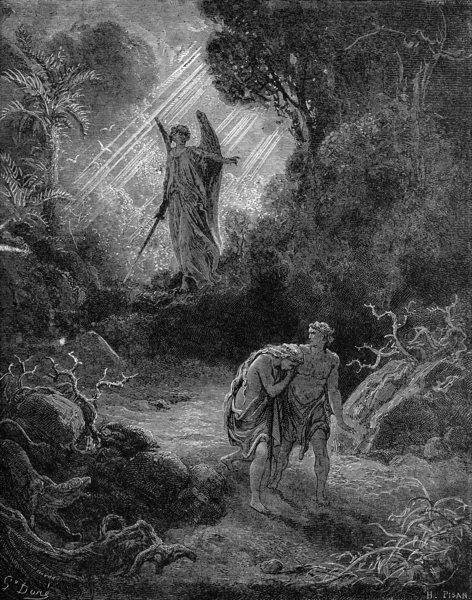
In Muntaka Upanishad of Hindu philosophy chapter third
describes a symbolic story of two birds. One is adma
(soul) and another is jeev(life). Both are sitting in a fig
(ficus) (pippala) tree. Jeev eats the fruit of fig tree
(Pippala) and adma(soul) is looking at her without any
influence.. This story is told to explain even though
the life (living being) is doing the worldly things
(including sex) it will not affect the soul inside.
muntakam means clean shavened head. this
upanishad is for the people who have sacrificed
the worldly life and searching for the eternal
wisdom. hence this name.
this symbolises determination. this is in atharvana
vetha(fourth).
ohm......the brahma who has created this world
and saving us is the first. he teaches this to his son satharvar. ...........1.1
atharvar teaches this to angirar angirar
teaches this to sathyavahar.
sathyavahar teaches this to angirashar(teacher
of english the derivative of sanskrit.)...1.2
third chapter first para.
there are two birds in a tree. they are
inseparable and equally powered. one is eating
the fruit in that tree and the other is looking at it
without eating the fruit. .........1.1
the bird that ate the fruit lost its control and
is in pain and sorrow. when it see the other bird
realises its fault and recovered from its
sorrow. ...........1.2
one bird is adma(soul)and the other bird is jeev
(life). here jeev eats the fruit and the adma is
looking at it without any attachment.
interesting thing in this small story is the
comparison of adam and eev story. eev eats
the fruit and adam is looking at her without
eating it.
adma is adam and jeev is eev. upanishads are
more than five thousand years old and bible
is two thousa nd years old. even after three
thousand years the base, the root of the story
is not changed much.
while it is piple tree in upanishad it is bible
in other.
when one can see the brahmam from its origin
the god which is having the brightness of gold he
will be away from all the sins and virtues and will
be merging with the god easily. ......1.3
The interesting thing in this story is comparison of
the Adam and Eve of Bible with this. The following
points are coincide. Adam and adma. Eve and jeev.
pipple and bible. fig is fig (not changed). forbidden
fruit is forbidden fruit (not changed).
Upanishads are 5000 years old. Bible is 2000 years
old. Author Pippala (rishi) (hermit) was living 2500
years ago. Jesus 2000 years. Is it possible that this
story has taken this new shape in 3000 years?
Readers can do research on this subject.
refer / search Deivathin kural written
by H.H. Chandrasekarendra Saraswathi swamiji of
Kanchi Kamakoti
peetam. visit http://www.kamakoti.org or read
muntaka upanishad in http://www.ashokha.co.cc
or visit http:www.wikipedia.org and read upanishads.
சந்திர சேகர சுவாமிகள் ஒரு அருமையான உதாரணம் சொல்லுவாங்க. மடத்துலே ஒரே ஒரு ராமு தான் இருந்தான் . அவனை எல்லோரும் ராமு என்று மட்டும்தான் கூப்பிட்டாங்க. அப்புறம் இன்னொரு ராமு வந்தான். இவன் தஞ்சாவூர்க்காரன். அதனால் இவனை தஞ்சாவூர் ராமு என்றும் அவனை கும்பகோணம் ராமு என்றும் கூப்பிட ஆரம்பித்தார்கள். அதேமாதிரி உலகம் பூரா ஒரே ஒரு மதம்தான் இருந்தது. அதனாலே அதற்கு தனியே வேறே பேரு எதுவும் கிடையாது. அப்புறம் இரண்டு மூணு மதங்கள் வந்துது. சநாதன மதத்துக்கும் ஒரு பேர ஊரே சேர்ந்து வச்சுடுத்து. நாம்தான் எல்லாவற்றையும் ஏத்துக்கிரவலாச்சே இதுக்கும் மண்டையை ஆட்டி வச்சோம். இப்போ பழசெல்லாம் மறந்து போச்சு.
His holiness sri Chandrasekarendra Swamigal of kanchi mutt has told an excellent
example for this. In the beginning there was only one Ramu as a
worker. He was simply called as “Ramu”. Later another Ramu joined in the mutt. After that he was called as “Thanjavur
Ramu’ and the another was called asKumbakonam
Ramu. Similarly as there was only one
religion (we must not even say religion here as it was civilization that has
grown in due course) there was no special name for this. Then came two orthree religions and the
world put a name for our ancient civilization.
As it is our habbit for nodding ourhead for everything we had nodded our
head for this also. In due course we
forgot everything.

It is possible to develop some new ideas from an old one. The world may have only one system of culture. Jesus may visit India learn some philosophy and then taught them in western countries. The age 12 to 30 of Jesus has not been mentioned in Bible. During that age he would be here. As his disciple has visited India 50 years after the death of Jesus it was possible for Jesus also to visit India and learned something here. He himself has told in the cross I have wrongly taught some higher policies to barbarians and met the consequences.
ReplyDeleteyes St.Thomas has visited India and settled in Kerala and spread christianity here and died here.it is after 50 years of jesus death.
ReplyDeleteyes St.Thomas has visited India 50 years after the death of Jesus and settled in Kerala. Even today Kerala is a Christian dominated state.
ReplyDelete